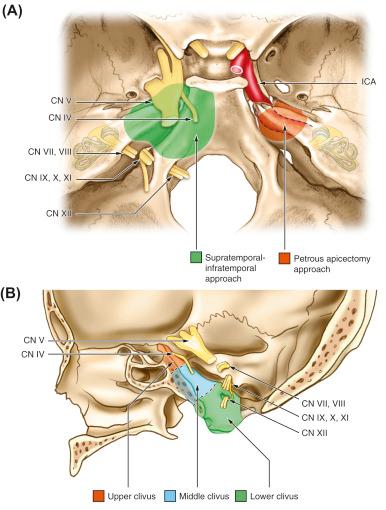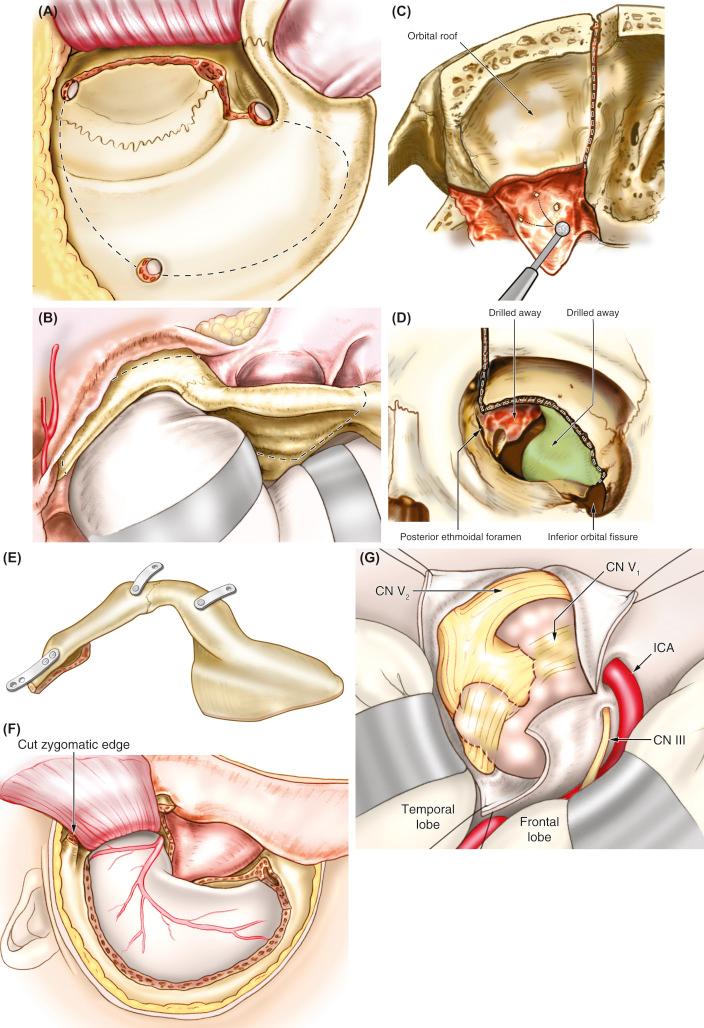Physical Address
304 North Cardinal St.
Dorchester Center, MA 02124
© 2018 Elsevier Inc. All rights reserved. Please note that the copyright for the original figures submitted by the contributors is owned by Contributors.
Chordomas and chondrosarcomas of the skull base are pathologically and genetically distinct neoplasms that are often grouped together because of their similar radiologic, anatomical, and surgical features. Although rare tumors, compromising only about 0.15% of all intracranial tumors, they are, nonetheless, important pathologies because of the tendency to recur and to be locally invasive. Complete or near-complete resection followed by high-energy radiotherapy is used in the management of both lesions. An operative approach, in single- or multistage procedures, must be devised to maximize the probability of complete tumor removal, as this has been shown to have a dramatic impact on overall survival. In this chapter, we discuss the techniques and indications for subtemporal–preauricular infratemporal fossa approaches.
Developed in 1987 by Sekhar and colleagues, the subtemporal–preauricular infratemporal fossa approach arose from modifications of the infratemporal fossa approach, first described in 1977 by Fisch, and of the middle fossa and transcochlear approaches, pioneered by House in 1963 and 1976, respectively. The subtemporal–preauricular infratemporal fossa approach is a primarily extradural route to the lateral and posterior skull base. It provides access to the anterolateral skull base with a shallow-angle exposure of the lateral midclivus ( Fig. 16.1A and B ).

The infratemporal fossa is bounded superiorly by the floor of the middle cranial fossa (squamous temporal bone and greater wing of the sphenoid), posteriorly by the cervical vertebrae, laterally by the mandibular ramus and condyle, and medially by the lateral pterygoid plate, pterygopalatine fossa, nasopharynx, and adjacent clivus. Surgical approaches to this region—as described by Fisch—achieve similar exposure, but necessitate disruption of the local anatomy and result in permanent conductive hearing loss (Fisch types A, B, and C) as well as facial nerve palsies due to cranial nerve (CN) VII transposition (Fisch types A and B). Translabyrinthine, transotic, and transcochlear approaches provide progressively more anterior exposure to the cerebellopontine angle, anterolateral brainstem, and clival area. These, however, cause ipsilateral hearing loss and, when the facial nerve is rerouted (transcochlear approach), at least temporary facial nerve palsy. The subtemporal–preauricular infratemporal fossa approach provides an anatomic exposure of the region, while avoiding the morbidity associated with facial nerve transposition and surgical disruption of the hearing apparatus.
We consider two primary variations of the subtemporal–preauricular infratemporal fossa approach: the subtemporal transzygomatic apical approach (STA) and the subtemporal–infratentorial approach (ST–ITA). The STA consists of a frontotemporal exposure combined with a zygomatic osteotomy (often combined with an orbital osteotomy) to provide access to the middle fossa, petrous apex, upper clivus, horizontal petrous internal carotid artery (ICA), and posterior cavernous sinus (CS) ( Fig. 16.2A–G ). The ST-ITA is an inferior extension of the STA into the neck and is used when the petroclival bone is involved inferior to the level of the horizontal segment of the petrous ICA. The ST-ITA provides additional exposure of the clivus to the level of the foramen magnum; the CS; the sphenoid, maxillary, and ethmoidal sinuses; the infratemporal fossa; and the retro- and parapharyngeal spaces and the orbit.

The subtemporal–preauricular infratemporal approach is useful for lesions involving the middle clivus (from the petrous apex to the jugular foramen) and the petrous apex.
It also provides access to the middle cranial fossa, infratemporal fossa, sphenoid area, parapharyngeal and retropharyngeal spaces, and the CS.
Although best suited for extradural lesions, the subtemporal–preauricular infratemporal approach may also be used to remove tumors with intradural extension.
Combination with an intradural subtemporal approach yields access to tumors ventral to the brainstem from the trigeminal root down to the hypoglossal foramina.
Tumor extension inferior to the level of the hypoglossal canal or across the midline may be difficult to remove by this approach.
Any opening into the nasopharynx is important to recognize because it precludes a one-stage intra- and extradural procedure due to the risk of infection and the integrity of the vascular grafts.
If the tumor has both intra- and extradural involvement, the extradural portion is performed first unless there is significant mass effect from the intradural portion.
Become a Clinical Tree membership for Full access and enjoy Unlimited articles
If you are a member. Log in here